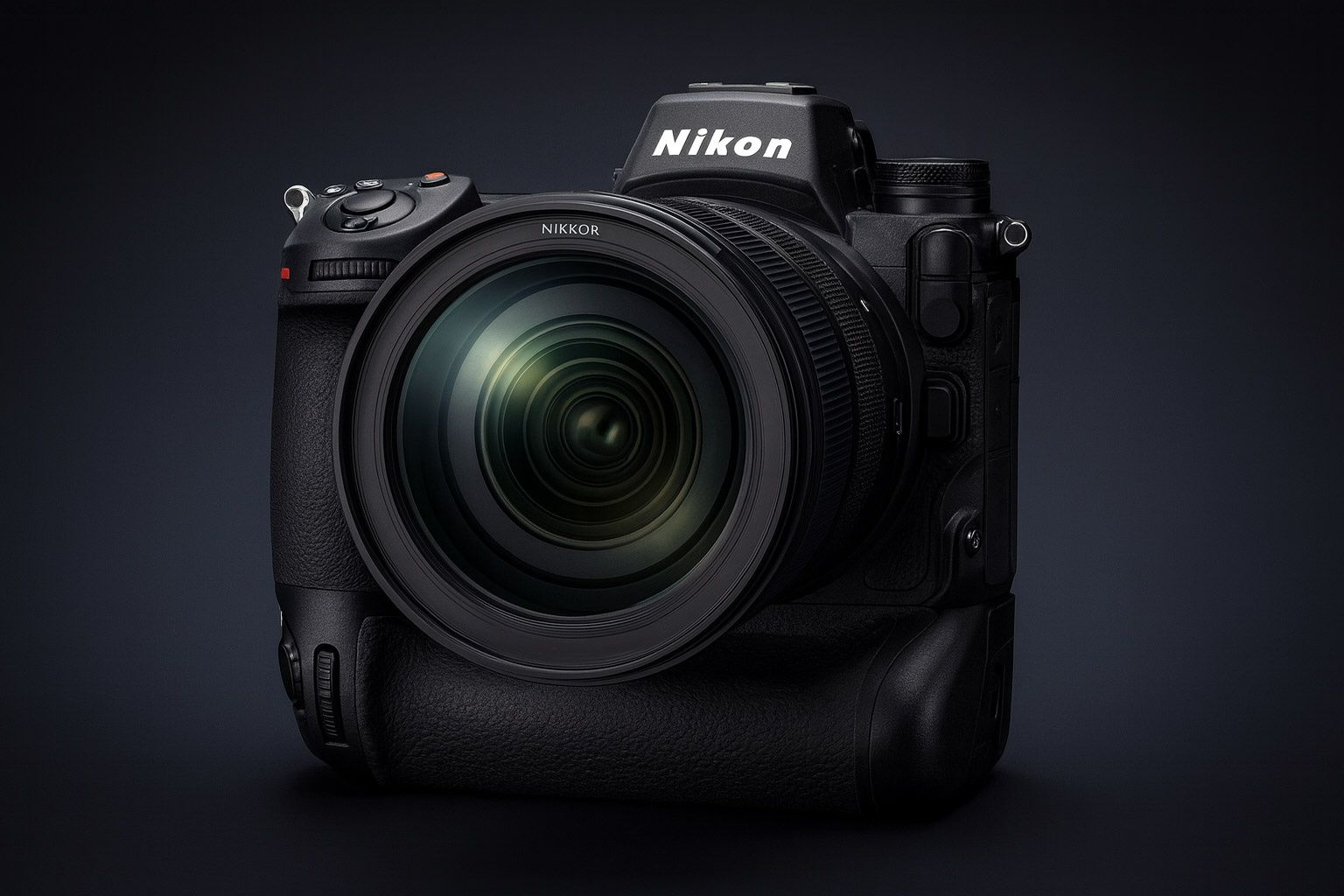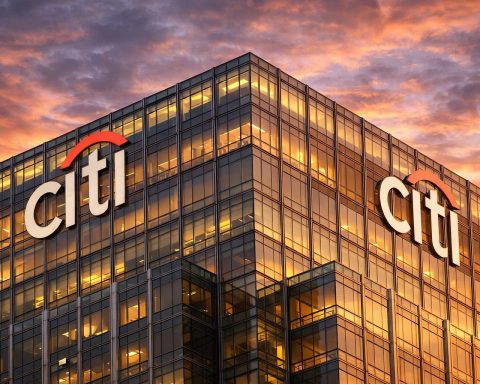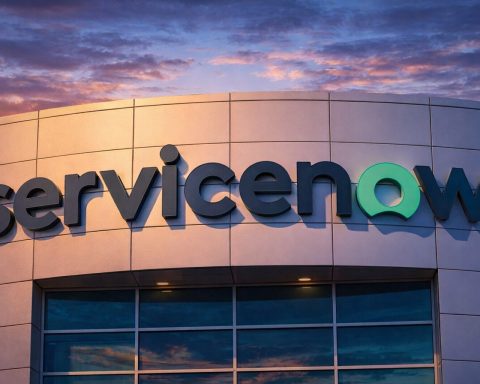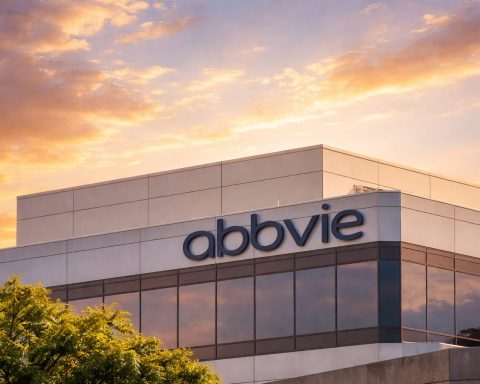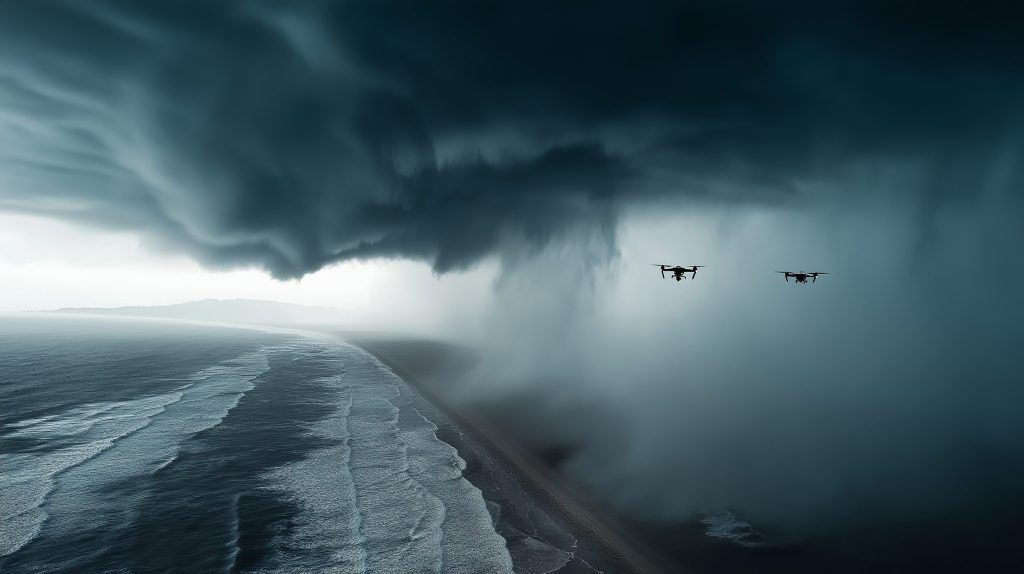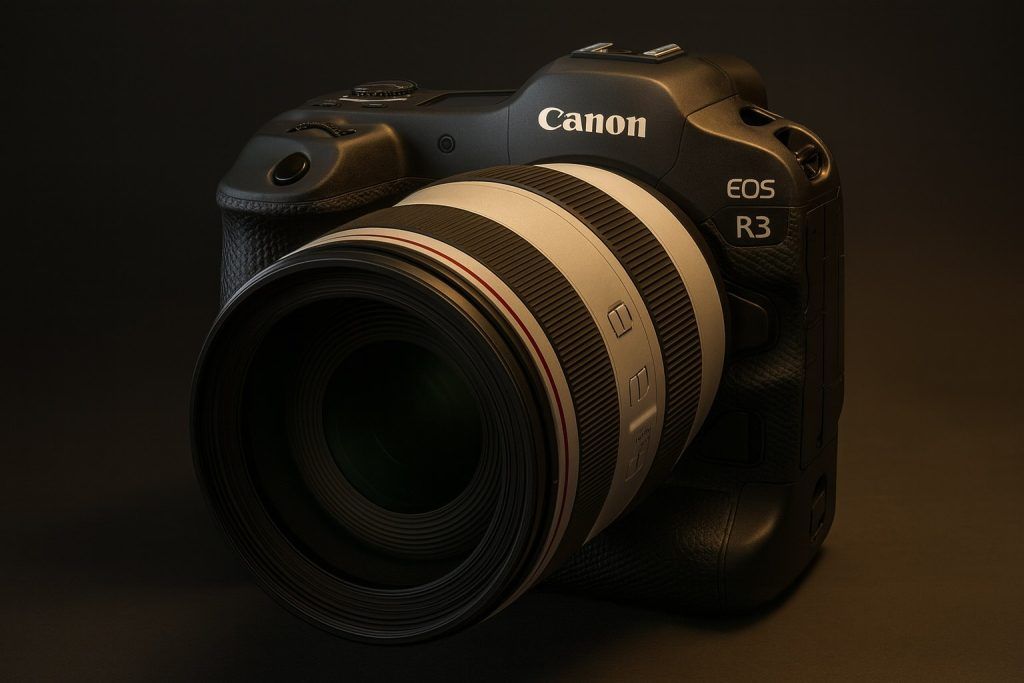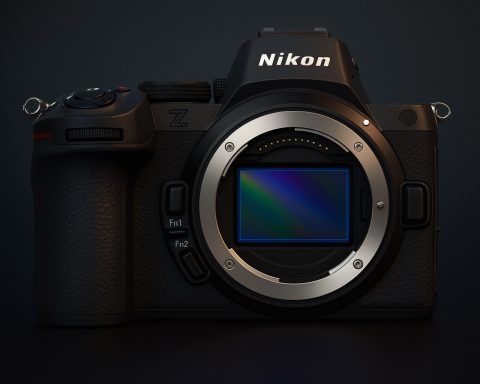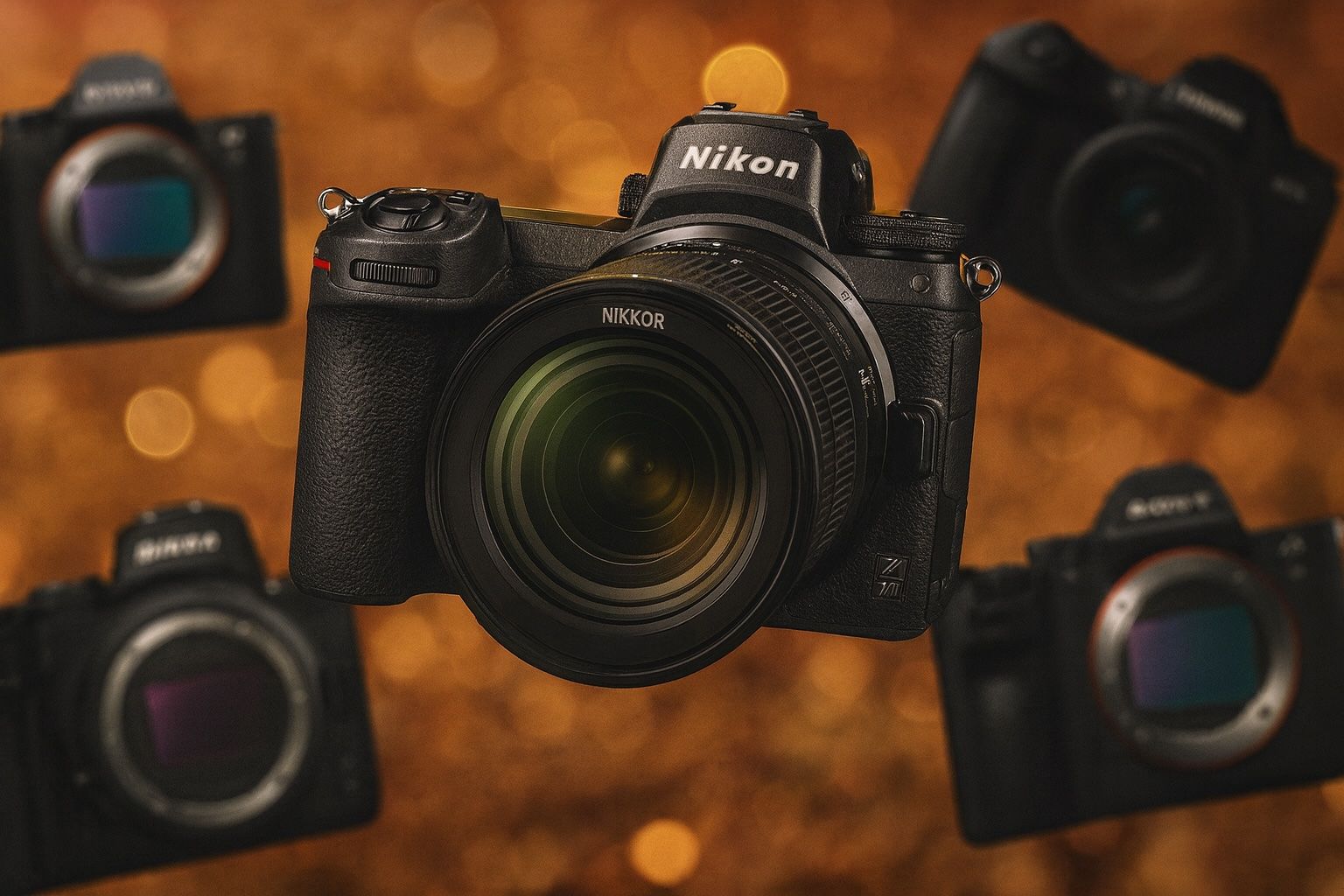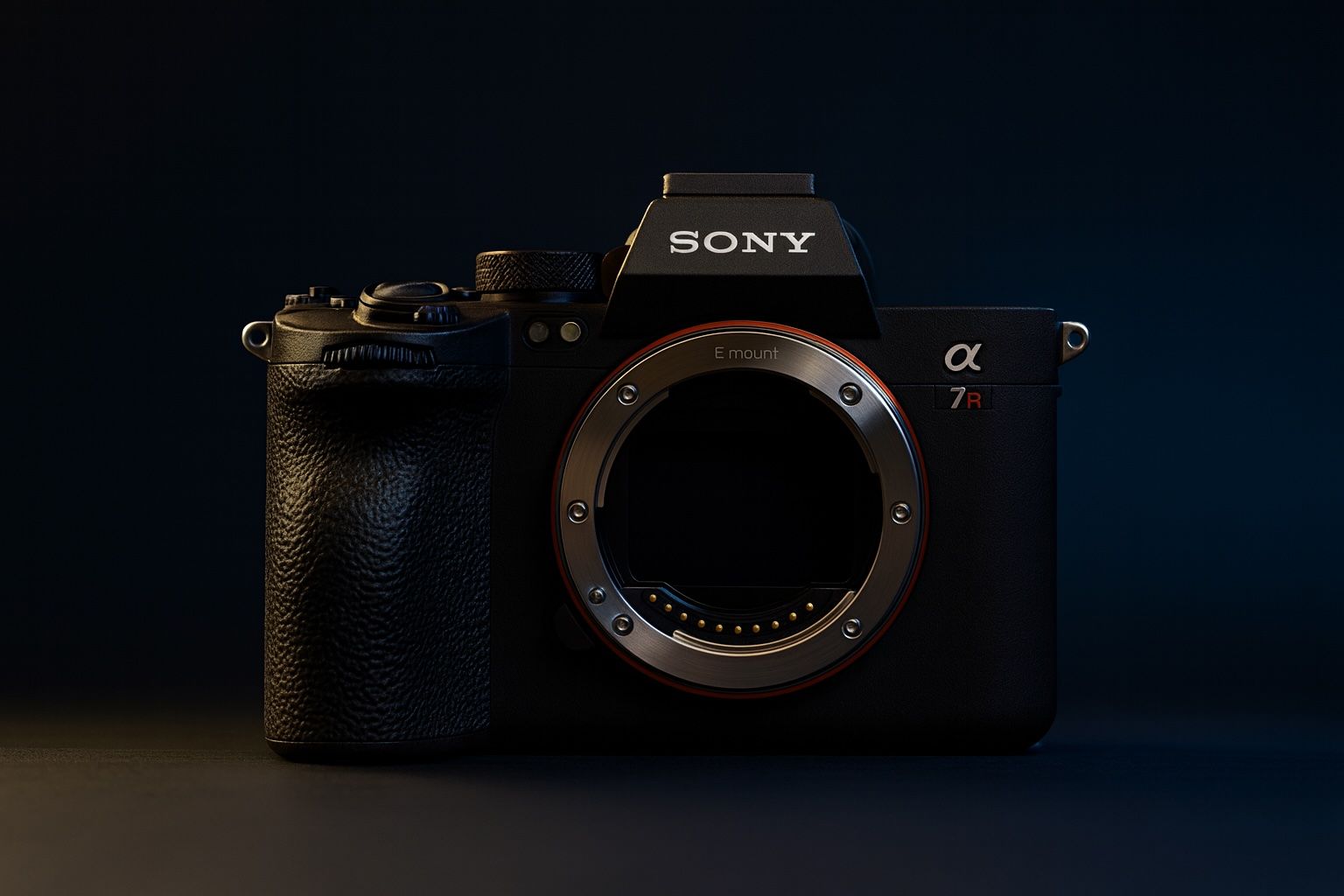- Nikon Z9 uses a 45.7 MP stacked CMOS sensor with EXPEED 7 and can record 8K/60p RAW internally (N-RAW) plus 4K/120p.
- Nikon Z8 also uses a 45.7 MP stacked CMOS sensor, shares the speed with the Z9, and can record 8K/60p N-RAW or 8K/30p ProRes 422 with 4K/120p.
- Nikon Z6 III employs a 24.5 MP partially stacked CMOS sensor with 3.5x faster readout than the Z6 II, enabling 120 fps bursts and 6K video, ISO 100–51,200.
- All three cameras feature 9-type subject detection with 3D Tracking for humans, animals, vehicles, and more.
- Shutter wise, the Z9 and Z8 are electronic-only (min 1/32,000s; flash sync 1/200s), while the Z6 III uses mechanical plus electronic shutter up to 14 fps.
- The Z9 and Z8 deliver a 3.69M-dot blackout-free OLED EVF, whereas the Z6 III offers a higher-resolution 5.76M-dot EVF with 3000–4000 nits brightness and 60 Hz (120 Hz sport) modes.
- All three offer 10-bit N-Log/HLG video, with the Z9 and Z8 adding internal ProRes HQ and N-RAW, while the Z6 III can record 6K RAW and 6K ProRes RAW up to 60p.
- IBIS is 5-axis for all three, up to ~6 stops with Synchro VR on the Z9/Z8, and 8 stops on the Z6 III.
- The Z9 weighs about 1340 g with battery, the Z8 about 910 g, and the Z6 III about 715 g, with weather sealing across the lineup and options like MB-N12 or MB-N14 grips.
- As of August 2025, pricing stands around $5,200 for the Z9 body with a Sept. 2025 rise to $5,899, about $3,800–$4,000 for the Z8 with a rise to $4,299, and $2,200–$2,500 for the Z6 III with a rise to $2,699.
Overview – Flagship Nikon Z Series Face-Off
Nikon’s full-frame mirrorless lineup has matured rapidly, and three models stand out in 2025: the Nikon Z9, Nikon Z8, and Nikon Z6 III. These cameras represent Nikon’s flagship and high-end offerings, each with a distinct role. The Z9 is the uncompromising pro-level flagship, the Z8 brings much of the Z9’s power in a smaller body, and the Z6 Mark III is a versatile mid-range hybrid that inherits many high-end features at a lower price point. This comparison will delve into their specifications, real-world performance, target users, pricing (as of August 2025), expert opinions, and even what’s next in Nikon’s Z series. Whether you’re a tech-savvy enthusiast or a working professional, this guide will clarify which model best fits your needs.
Key Specifications Comparison
To set the stage, here’s a side-by-side look at the core specs of the Nikon Z9, Z8, and Z6 III:
| Feature | Nikon Z9 (Flagship) | Nikon Z8 (High-End Hybrid) | Nikon Z6 III (Mid-Range Hybrid) |
|---|---|---|---|
| Sensor & Resolution | 45.7 MP Stacked CMOS (Full-frame) | 45.7 MP Stacked CMOS (Same as Z9) | 24.5 MP “Partially Stacked” CMOS [1] |
| Image Processor | EXPEED 7 | EXPEED 7 | EXPEED 7 |
| ISO Range | 64–25,600 (expand 32–102,400) | 64–25,600 (expand 32–102,400) | 100–51,200 (expand 50–204,800) |
| Continuous Shooting | Up to 20 fps RAW, 30 fps JPEG; 120 fps @11MP | Up to 20 fps RAW, 30 fps JPEG; 120 fps @11MP | Up to 20 fps RAW (e-shutter), 14 fps mech.; 60 fps JPEG full-res (120 fps in APS-C crop) [2] |
| Autofocus System | Advanced AF w/ 3D Tracking; subject detect (people, animals, vehicles – 9 types) | Same as Z9 (3D Tracking, 9 subject types) | Inherited from Z8/Z9: 9 subject detection, 3D Tracking, improved low-light AF (-10 EV) |
| Video Capabilities | 8K up to 60p (12-bit RAW); 4K up to 120p; 10-bit internal N-Log/HLG | 8K up to 60p (N-RAW); 4K up to 120p; 10-bit ProRes 422 HQ, N-Log/HLG | 6K up to 60p (N-RAW) [3]; 4K up to 120p (oversampled from 6K); 10-bit ProRes 422 and H.265 support |
| Electronic Viewfinder | 3.69M-dot OLED; blackout-free low-lag feed | 3.69M-dot OLED; blackout-free low-lag feed | 5.76M-dot OLED; ultra-bright (4000 nits) and wide color gamut [4] |
| Rear LCD Monitor | 3.2” 2.1M-dot 4-axis tilting touchscreen | 3.2” 2.1M-dot 2-way tilting screen | 3.2” 2.1M-dot fully articulating touchscreen [5] |
| In-Body Stabilization | 5-axis IBIS (up to ~6 stops with Synchro VR) | 5-axis IBIS (up to 6 stops with lens VR) | 5-axis IBIS rated 8.0 stops (enhanced) [6] |
| Shutter | Electronic only (no mechanical; 1/32,000s min; 1/200s flash sync) | Electronic only (no mechanical shutter) | Mechanical + Electronic (mech. up to 14 fps) [7] |
| Storage (Card Slots) | Dual CFexpress Type B | 1× CFexpress Type B + 1× SD UHS-II | 1× CFexpress Type B (XQD compatible) + 1× SD UHS-II |
| Battery | EN-EL18d, Integrated grip (approx. 700+ shots) | EN-EL15c (approx. 340 shots CIPA); optional grip available | EN-EL15c (approx. 360 shots CIPA); optional MB-N14 battery grip |
| Body Build | Pro-size magnesium alloy, built-in vertical grip (1.34 kg) – flagship weather sealing | Magnesium alloy + carbon fiber, no built-in grip (910 g); flagship-level sealing | Magnesium alloy + Sereebo® carbon fiber, (758 g); sealed same as Z8 |
| Launch Price (USD) | $5,500 (late 2021) | $3,999 (mid-2023) | $2,499 (mid-2024) [8] |
| Price (Aug 2025) | ~$5,200 (body only) | ~$3,800 (body only) | ~$2,200–2,500 (body only) |
Table: Key specifications of the Nikon Z9, Z8, and Z6 III full-frame mirrorless cameras, as of 2025.
As the table shows, all three cameras share Nikon’s latest-generation technology (EXPEED 7 processor, advanced autofocus, in-body stabilization, etc.), but they diverge in sensor resolution, speed, body design, and price. Next, we’ll break down these differences in detail.
Sensor and Image Quality
Resolution and Sensor Type: The Z9 and Z8 both use a 45.7-megapixel stacked CMOS sensor – a high-resolution sensor with incredibly fast readout. This stacked design enables the Z9/Z8 to shoot 45 MP images at lightning speed and contributes to superb image quality with a base ISO of 64 for wide dynamic range. In contrast, the Z6 III uses a new 24.5 MP “partially stacked” CMOS sensor [9]. While it has roughly half the resolution, this sensor is unique: Nikon layered extra readout circuits at the top and bottom, achieving some of the speed benefits of a stacked sensor but at lower cost. The result is faster data handling than previous 24 MP models – Nikon claims a 3.5× faster readout than the Z6 II, unlocking capabilities like 120 fps bursts and 6K video that were previously impossible in this class.
Despite the resolution gap, all three sensors deliver excellent image quality in their intended use. The 45.7MP Z9/Z8 sensors excel for detailed landscapes or large prints, and still offer low base ISO (64) for maximum dynamic range (their design is similar to the Nikon Z7 series sensor, just with far faster readout). The 24MP Z6 III sensor has a base ISO 100 and slightly less dynamic range at base ISO (Nikon traded a bit of base ISO DR for speed). In real terms, most photographers won’t notice much difference in image quality for typical shooting: the Z6III “has more dynamic range than most people use,” and its minor reduction in shadow recovery is only a concern for extreme high dynamic range scenes (like bright sunrise/sunset landscapes). If you do need ultra-high resolution for landscapes or studio work, the 45MP of the Z8/Z9 has the edge – otherwise, the Z6III’s image quality holds its own with superb sharpness, color, and ISO performance, now paired with far better speed and AF than earlier 24MP bodies.
ISO and Low-Light: The native ISO ranges differ slightly. The Z9 and Z8 span ISO 64–25,600 (expandable to 32–102,400), whereas the Z6III covers ISO 100–51,200 (expandable to 50–204,800). In practice, high-ISO performance is similar across the three (all use modern BSI sensors and EXPEED 7 processing). The Z6III’s larger pixels might give it a slight edge in extreme low-light noise, but the differences are small. Notably, the Z6III’s new sensor has exceptional low-light autofocus sensitivity down to -10 EV, which is actually better than the flagship models (Nikon improved the AF sensor circuitry). This means the Z6III can focus in extremely dark conditions (like dim starlight or candlelight) a bit more reliably, which is impressive for a mid-range body.
Special Modes: All three cameras include Nikon’s latest creative options. For instance, the Z6III introduces a Pixel-Shift High Resolution mode, shifting the sensor to composite up to 96MP images for static subjects – a feature not present in the Z8/Z9. This caters to landscape or product photographers who occasionally need extra resolution. On the other hand, the Z9/Z8 can shoot 10-bit HEIF HDR stills and have a base ISO 64, which can be advantageous for maximum dynamic range in bright conditions. In summary, if resolution is paramount, the Z9/Z8 win; but the Z6III’s sensor is no slouch and even brings new tricks (fast readout, pixel shift) to the table.
Autofocus and Continuous Shooting
One of Nikon’s biggest strides with these models is autofocus (AF) performance. The Z9 debuted a radically improved AF system with subject detection powered by machine learning, and that DNA flows into the Z8 and Z6 III.
AF Systems: All three use Nikon’s advanced subject recognition AF that can detect and track nine subject types (humans, dogs, cats, birds, cars, motorcycles, bicycles, trains, and planes). This is paired with Nikon’s beloved 3D Tracking mode for sticky focus on moving subjects. In the Z9 and Z8, this system was a game-changer, finally putting Nikon on par with rival flagships in AF. The Z9’s autofocus is “powerful and easy to use and works well for both stills and video”. The Z8 inherits this wholesale – in fact, “in almost every respect, the Z8 is a match for the Z9” including autofocus and burst performance.
The Z6 III, despite being an “enthusiast” body, benefits enormously from trickle-down tech. It uses the same EXPEED 7 processor and AF algorithms as the Z9/Z8, resulting in a huge leap over earlier Z6 models. “Processing and AF systems developed in the top-end Z9” have turned the Z6III into a “genuine do-anything camera,” says DPReview, noting its AF is now competitive with peers. In challenging scenarios (fast action, erratic subjects), the Z9 and Z8 still hold a slight edge – their stacked sensor readout is even faster, and they’ve received additional firmware updates refining AF. For example, the Z8/Z9 gained a dedicated airplane and bird mode in firmware, whereas the Z6III includes bird detection but not as a separate mode. In practice, the Z6III’s autofocus is only a notch behind the Z8: “Its autofocus isn’t quite as confidence-inspiring as the excellent Z8, but it’s a big step forward… making it competitive for its class.”. For most users and most subjects, all three cameras now focus swiftly and accurately, with eye-detection that locks onto people and animals reliably.
Burst Shooting: This is where the sensor differences really show. The flagship Z9 (and Z8) can shoot up to 20 fps RAW (full-resolution 45MP RAW images) with tracking AF, and even 30 fps full-res JPEG or 120 fps in a 11MP cropped JPEG mode for extreme speed needs. Equally important, the Z9/Z8 have deep buffers – the Z9 can clear over 1000 RAW frames at 20 fps (with high-efficiency compression) without slowing, meaning you won’t easily outrun it in a burst. The Z8 matches the Z9’s burst rates (20 fps RAW, etc.) since it uses the same sensor/processor, though its smaller body and single CFexpress slot may give it a slightly smaller buffer (still ample for most uses).
The Z6 III, surprisingly, is no slouch either. Thanks to its partially stacked sensor, it achieves 14 fps with the mechanical shutter and 20 fps with electronic shutter in full 24MP RAW [10]. That’s on par with many pro sports cameras of just a few years ago. It can even shoot 60 fps JPEG at full resolution, or 120 fps JPEG in a cropped (APS-C) mode, using a pre-buffer to catch action before you fully press the shutter [11]. Essentially, the Z6III gives up resolution but gains speed – “up to an incredible 120fps” is available (with some caveats) and 20fps RAW, which in practice is more than you’ll need for most action. Reviewers found this yields a “fantastic hit rate” of in-focus shots in sports, as long as you pair it with the “superb autofocusing system brought over from the Z8 and Z9”, making the Z6III a legitimate action camera.
Electronic vs Mechanical Shutter: The Z9 and Z8 famously have no mechanical shutter at all – they rely entirely on the fast sensor readout for electronic shutter capture. This design eliminates moving parts and allows silent shooting and ultra-high frame rates (120 fps). Nikon’s stacked sensor readout is so fast that the Z9 achieved a flash sync of 1/200s electronically, comparable to a mechanical shutter sync. The downside is potential rolling shutter distortion under very fast motion or banding under certain artificial lights; however, the Z9/Z8’s sensor readout is the fastest among full-frames, minimizing these issues. The Z6 III does retain a mechanical shutter (useful in some strobe lighting to avoid banding) but can choose electronic first-curtain or full electronic for silent shooting. Its electronic burst tops out at 20 fps RAW, and rolling shutter is slightly more noticeable than the stacked 45MP sensor (e.g., fast panning might bend straight lines a bit). Still, Nikon managed a 1/60s electronic flash sync on the Z6III, implying a very swift readout for a 24MP chip. Bottom line: For most shooters, all three offer more than sufficient speed – the Z9/Z8 are overkill for action unless you truly need 45MP at 20 fps or are shooting professional sports, while the Z6III’s 20 fps RAW will nail decisive moments in anything from wildlife to kids’ soccer games.
Video Capabilities
In the mirrorless era, video is as crucial as stills for many users. All three cameras are highly capable video machines, but aimed at different levels of production.
Resolution & Frame Rates: The Nikon Z9 is a video beast – it was Nikon’s first camera to offer 8K recording. Out of the box it could do 8K at 30p and 4K up to 120p. Firmware updates unlocked 8K/60p RAW internally. The Z9 can shoot 12-bit RAW video internally (N-RAW or ProRes RAW) and also offers 10-bit ProRes 422 HQ and H.265 options. Essentially, it’s a true hybrid stills/video flagship without the typical video time limits (the Z9 has no 30-minute cap and features advanced heat dissipation). The Z8 inherits virtually all these video specs: it also records 8K/60p in N-RAW or up to 8K/30p in ProRes 422, plus 4K/120p slow-mo. In fact, Nikon markets the Z8 as “the ultimate hybrid camera” with powerful video and still capabilities in one. The main difference is the smaller Z8 may have shorter continuous recording endurance – users found that in 8K or 4K/120 high-bitrate modes, the Z8 could overheat after roughly 30-60 minutes, whereas the Z9’s larger body can sustain recording longer. However, for most projects and 4K usage, the Z8 handles it well, and it even has dual USB-C ports (one for power delivery, one for data) to support video workflows.
The Z6 III, aimed at enthusiast creators, forgoes 8K due to its 24MP sensor but still reaches an impressive 6K/60p in 12-bit N-RAW or ProRes RAW [12]. It can record oversampled 4K UHD up to 60p (downsampled from the 6K for extra detail) and can do 4K/120p for slow-motion (likely with a slight sensor crop or line-skipping). Full HD can go to 240p for 10× ultra slow-mo. The Z6III’s ability to shoot 6K video allows capturing more detail and then outputting crisply downsampled 4K – a benefit for content creators who want flexibility to crop or stabilize footage in post. It also has no 30-minute limit and features an improved heat dissipation design; Nikon claims continuous 4K/60p recording for up to ~125 minutes is possible on the Z6III (with an external power source).
Video Quality & Features: Across all three, Nikon includes 10-bit N-Log and HLG (HDR) recording internally. The Z9/Z8 add professional codecs (internal ProRes HQ and Nikon’s N-RAW format) which are huge for high-end video production. The Z6III, remarkably, also offers internal RAW video (both 6K N-RAW and 6K ProRes RAW up to 60p) just like the flagships. This means even the mid-range model supports advanced workflows like RAW video editing and HDR output. All three have focus peaking, zebras, and Nikon’s new waveform monitor (Z6III and Z8 gained waveform video displays, which videographers love). Rolling shutter: With their stacked sensors, the Z9/Z8 have very well-controlled rolling shutter in video – fast motion is rendered with minimal skew. The Z6III’s faster readout (compared to older 24MP sensors) also reduces rolling shutter significantly, so that 6K footage is stable even when panning; DPReview noted “lower rolling shutter” on the Z6III and class-leading AF tracking during video, which together make it a “significantly improved video camera” for its class.
One difference is viewfinder/live-view operation during video: The Z9/Z8’s “Real-Live Viewfinder” design feeds a low-lag signal from a second output on the stacked sensor, so there’s effectively no blackout or lag when starting to record or during bursts. The Z6III, with a single feed, might blank the EVF momentarily when starting a recording or burst (a minor point unless you’re switching between stills and video frequently).
Ports and Power: All three cameras provide mic and headphone jacks, HDMI output (the Z8 and Z9 have a full-size HDMI port, which is more robust for external monitors/recorders; the Z6III likely has micro-HDMI), and USB-C. The Z8 even has two USB-C ports, letting you power the camera while using another device. The Z9’s larger battery can support longer shooting without external power, whereas Z8 and Z6III users doing long video takes often use a dummy battery or USB PD power bank for extended recording.
In summary, the Z9 and Z8 target pro filmmakers – they can effectively replace a cinema camera for many uses, recording 8K RAW and high-quality 4K internally. The Z6III targets hybrid shooters and content creators, offering robust 4K/6K capabilities that surpass other cameras in its price range (it’s arguably more video-feature-packed than its direct competitors, Canon R6 II or Sony A7 IV). Unless you specifically need 8K or the absolute minimal rolling shutter, the Z6III will more than satisfy most videographers with its 6K oversampled quality and “impressive feature set”, while the Z9/Z8 are there for those who demand the no-compromise, high-end video specs.
Design, Build and Handling
Each camera’s physical design reflects its target user and influences handling and usability in the field.
Body and Ergonomics: The Nikon Z9 is a large, integrated-grip body – essentially the size of a pro DSLR like Nikon’s D6. It’s built of robust magnesium alloy and weather-sealed to endure harsh pro use. Weighing about 1340g (just under 3 lbs with battery), the Z9 is hefty. The upside is excellent balance with large telephoto lenses and a generous grip (both horizontal and vertical grips built-in). Controls are abundant: the Z9 has 14 customizable buttons on the body and backlit illuminated buttons for low-light operation. If you’re coming from a flagship DSLR, the Z9 feels familiar and rock-solid – truly “Pro build”, as Nikon advertises. The Z8, by contrast, is a “mid-sized” pro body – think of it as a D850-style form factor. It weighs ~910g (2.0 lbs) with battery, much less than the Z9, and omits the vertical grip for a more compact profile. The Z8’s build is still tough: a mix of magnesium alloy and carbon fiber composite, with sealing equivalent to the Z9’s level. Nikon even states the Z6III and Z8 share the same degree of weather sealing. In hand, the Z8 offers a good deep grip for landscape orientation; if you shoot a lot of portraits or sports, Nikon sells an MB-N12 battery grip for the Z8 to add vertical controls and additional battery capacity. Essentially, the Z8 gives you flagship performance in a body that’s easier to carry all day or travel with, albeit at the cost of shorter battery life and slightly less “tank-like” feel compared to the Z9.
The Z6 III shares a body design with the Z6/Z7 series – a compact yet solid mirrorless camera weighing ~715g (1.57 lbs) with card and battery. It’s built from magnesium alloy and Sereebo® carbon fiber (a high-strength composite) to keep weight down. Crucially, Nikon didn’t skimp on durability: the Z6III is sealed against dust and moisture to the same level as the Z8 and rated for operation down to -10°C. So while it’s not as bulky, it should handle adverse conditions admirably (many photographers successfully used Z6 and Z7 bodies in tough environments; the Mark III only improves on that). The grip is comfortable for most medium lenses, though with big telephoto lenses, a larger body (or adding the optional MB-N14 battery grip for the Z6III) can improve balance. Overall, handling is excellent – Nikon’s Z bodies have well-placed dials and a user-friendly interface. Each camera has plenty of direct controls; the Z9/Z8 have extra function buttons (and the Z9’s vertical grip duplicates controls), while the Z6III has slightly fewer buttons but a similar control layout that existing Nikon users will recognize.
Viewfinder (EVF): Here we see an interesting trade-off. The Z9 and Z8 both use a 3.68-million-dot OLED EVF (Quad VGA resolution). While some competitors have higher EVF resolution (Sony’s A7R V is ~9.4M dots), Nikon prioritized refresh rate and latency. The Z9/Z8 EVF has a dedicated feed from the sensor that virtually eliminates viewfinder blackout and lag, especially during burst shooting. In fact, Nikon calls it the “world’s first truly blackout-free EVF”, giving a real-time view even at 20fps bursts. This makes tracking fast action through the viewfinder seamless – sports shooters have noted it feels as immediate as an optical finder. The downside is the 3.69M dot resolution is “relatively low” by modern standards; fine details in the EVF may not appear as crisp as in some rival cameras. DPReview’s Barney Britton commented that coming from a 5.76M-dot EVF (like in a Panasonic S1R), the Z9’s live view, while lag-free, was not as detailed. Nikon figured most Z9/Z8 users would accept that trade-off for zero blackout, and for action photography that’s absolutely a boon.
The Z6 III, on the other hand, introduces Nikon’s new 5.76M-dot OLED EVF – their highest resolution EVF yet, with an ultra-bright 3000-4000 nits max brightness and wide color (DCI-P3 gamut). This EVF provides a exceptionally clear and lifelike image, even in bright outdoor light where lesser viewfinders can appear dim. TechRadar calls it “Nikon’s best yet… one of the best experiences on the market” for an EVF. The Z6III’s EVF runs at 60 Hz refresh by default (and a higher refresh “sport mode” likely at 120 Hz, though possibly with reduced resolution). For most users not shooting 20fps all the time, the extra detail in the viewfinder is appreciated – critical manual focus and composition are easier when you can see fine details. So, if you value a pin-sharp EVF image (say for landscape, studio, or general use), the Z6III actually outperforms its pricier siblings in that aspect. If your priority is an absolutely lag-free finder for tracking fast action, the Z9/Z8 EVF system is superior.
LCD Screens: Nikon took different approaches here: The Z9 debuted a nifty 4-axis tilting touchscreen (3.2” size, 2.1M dots) that can tilt both horizontally and vertically. This design is great for high or low angles in both landscape and portrait orientation (useful for studio or architectural shooters). The Z8 has a similar 2-axis tilt screen (tilts up/down for horizontal shots and also in portrait orientation). Neither Z9 nor Z8 has a front-facing option – in keeping with their pro focus, Nikon chose sturdy tilts over fully articulating hinges. The Z6 III, by contrast, has a fully articulating vari-angle screen that flips out to the side and rotates. This is more versatile for video (vlogging, self-recording) and creative angles, though some photographers prefer tilting for simplicity when shooting stills. The Z6III’s screen can face forward for filming yourself, something the Z9/Z8 cannot do without an external monitor. All three screens are touch-sensitive and high-resolution.
Storage and Connectivity: The Z9 features dual CFexpress Type B card slots – these offer the fastest speeds, essential for 45MP 20fps bursts and 8K video. The Z8 and Z6III each have a combo of 1× CFexpress Type B and 1× SD UHS-II slot. This gives flexibility (SD cards are cheaper and ubiquitous), but for video or fast bursts the CFexpress slot is recommended. All cameras can perform backup recording or overflow; note that video on the Z6III can only be recorded to the CFexpress slot due to bandwidth, not to the SD simultaneously. For connectivity, all have USB-C ports (the Z9 and Z6III support USB-C charging/power delivery; the Z8 has one USB for power and another for data). HDMI outputs are there for external recording (Z9: full-size HDMI, Z8: full-size HDMI, Z6III: likely micro HDMI). All support wireless connectivity (Wi-Fi/Bluetooth) for Nikon’s apps; interestingly, Nikon has introduced the Nikon Imaging Cloud service in 2024 alongside the Z6III for easier cloud backup and firmware updates over Wi-Fi.
Battery Life: The Z9 uses Nikon’s big EN-EL18d battery (same family as its pro DSLRs). CIPA-rated at ~700 shots, in real use it often exceeds that (especially with EVF framerate management). It’s built for endurance, and you can shoot an event on one battery in many cases. The Z8 and Z6III use the smaller EN-EL15c battery. CIPA ratings are around 340–370 shots per charge, but real-world often 600+ for stills, depending on usage. However, heavy 8K video or 120fps bursts will drain them faster. Both support USB Power Delivery to run the camera or charge the battery in-camera. For extended shoots, the optional battery grips (MB-N12 for Z8, MB-N14 for Z6III) let you use two batteries and add vertical controls – a must-have for some pros to mitigate the shorter battery life of these smaller bodies.
In short, the Z9 is built like a tank for all-day professional use, the Z8 offers a happy medium of pro features in a smaller package, and the Z6III packs high-end capability into a compact, travel-friendly form. All three are durable and handle very well; choosing between them often comes down to how much weight you’re willing to carry and whether you need the pro-oriented design features of the bigger bodies.
Real-World Performance and Usability
Spec sheets only tell part of the story. How do these cameras actually perform in the field for photography and videography?
Nikon Z9 – Performance: “The Nikon Z9 is perhaps the most complete camera we’ve ever tested,” raved DPReview. This sums up the Z9’s real-world prowess. It captures excellent 45MP images at up to 30 fps and its autofocus tracks subjects tenaciously even in challenging scenarios. Sports and wildlife photographers report that the Z9’s 3D Tracking combined with human/animal detection makes it easier than ever to keep fast-moving subjects in focus (for example, birds in flight or athletes). The lack of a mechanical shutter has not hindered most users – the Z9’s electronic shutter is so fast that even under indoor lighting, banding or distortion is rare. Event shooters love the silent shooting (no shutter sound to distract subjects). The viewfinder experience is often described as “DSLR-like”, given its real-time nature, which eases the transition for pros moving from optical viewfinders.
In video, the Z9’s performance is equally stellar. Professionals have used it to shoot high-end productions, taking advantage of 8K RAW for maximum quality or oversampled 4K for crisp results. The camera’s heat management has proven effective – no record limits and only in very extreme conditions will it overheat. Its footage grades well (N-Log and RAW give lots of flexibility). One trade-off: the Z9 is big and heavy, so for run-and-gun video or travel, carrying it (plus heavy glass) can be tiring. As DPReview concluded, the Z9 “combines the best of a DSLR and a video camera in a single body” – but indeed that body is large, so it’s not ideal when size/weight are critical (hiking, casual travel).
Nikon Z8 – Performance: The Z8 has been celebrated for bringing Z9-level performance in a smaller form. Photographers who have used both often say “it’s largely a miniature version of my Z9” in real-world use. It shoots the same images, with the same superb autofocus and burst speeds. In fact, the Z8 was selected as DPReview’s Product of the Year 2023, with one editor calling it “probably the best camera I’ve ever used”. It excels in action (sports/wildlife) and also in more sedate photography like portraits, weddings, and landscapes – a true all-rounder. The ergonomics are praised; despite being smaller, it still handles like a pro camera with generous controls and a solid grip. Users migrating from a D850 DSLR, for example, find the Z8 a natural successor (Nikon explicitly calls the Z8 a “true mirrorless successor to the wildly popular D850”).
In practice, the differences you’ll notice vs. the Z9 are: 1) The Z8’s battery life is shorter – for an all-day event, you’ll likely need spares or the battery grip. 2) If you shoot a lot of verticals (portraits), the add-on grip is advised for comfort. 3) For video, the Z8 can record the same quality as Z9, but some users did encounter overheating if trying to record long stretches of 8K or 4K/120 in hot climates. Firmware updates have improved this, but the Z9 still has a bit more thermal headroom thanks to its size. 4) The EVF resolution, as mentioned, is 3.69M; some studio and landscape shooters expressed a wish for a higher-res EVF on the Z8. However, those coming from the original Z7 or Z6 will find the Z8’s EVF similar in res but much better in responsiveness. For most photographers who don’t need the built-in grip, the Z8 hits a sweet spot. It “is a perfect companion to the Z9 and a solid upgrade from the Z7 II”, offering the same image quality and nearly the same functionality at a lower cost and weight.
Nikon Z6 III – Performance: The Z6III in real-world use is all about versatility. It may not have the headline-grabbing 45MP/8K specs, but as TechRadar puts it, this camera “is designed to be an all-rounder” that can tackle just about any subject, photo or video. And it delivers: autofocus performance is greatly improved from earlier mid-range models – testers note that almost every shot in a 20fps action burst can be in focus, thanks to the Z6III’s inherited AF system. DPReview’s review awarded it a Gold Award and stated it’s “comfortably the best Z6 model yet” and even “the most all-round capable camera in its class”, capable of rising to “almost any challenge you set it”. That is high praise considering its competition (Canon R6 II, Sony A7 IV).
In day-to-day shooting, the Z6III feels responsive and refined. It shoots quietly (mechanical shutter is very dampened, and of course silent in e-shutter). The 8.0-stop IBIS means you can handhold at absurdly slow shutter speeds – useful for low-light stills and smooth handheld video. The fully articulating screen makes it a favorite for one-person video creators or photographers who need odd angles. The camera’s smaller size is a boon for travel, street photography, or gimbal work. Where does it fall short of the big brothers? Primarily in the extremes: if you’re a sports pro who shoots 45MP images for magazine covers, the Z6III’s 24MP might not suffice. Its AF, while greatly improved, is a “big step forward” but not quite as confidence-inspiring as the Z8/Z9’s AF in the most demanding scenarios – for example, erratically flying birds against cluttered backgrounds might trip it up slightly more (and note it lacks a dedicated “bird subject” mode that the others got via firmware). Also, if you often shoot in the highest dynamic range scenarios (bright highlights and deep shadows), the Z6III’s RAW files have a bit less recoverable shadow detail than Z8/Z9 (due to the sensor’s design). For 99% of users, these are minor points. The upside is the Z6III is more affordable and “a do-everything camera that does a lot of things very well,” as DPReview concluded. It’s an exquisite balance of quality and performance – TechRadar even calls it “an exquisite all-rounder that’s close to perfection,” albeit noting it’s not cheap for a mid-range camera [13].
In summary, all three cameras are highly capable in real-world use. The Z9 is the no-holds-barred tool for professionals who demand maximum performance and can handle the size, the Z8 offers 95% of that performance in a more flexible form factor, and the Z6III brings many of those high-end capabilities to enthusiasts and creators in a lighter, more accessible package. The good news is you really can’t go wrong – Nikon has matured its mirrorless line such that even the “entry” model here can tackle sports, wildlife, portraits, or video with aplomb. Your choice will depend on your specific use cases and budget, which we address next.
Target Audience and Ideal Use Cases
Each model is tuned for a particular segment of photographers and videographers. Here’s who will get the most out of the Z9, Z8, and Z6III:
- Nikon Z9 – For Elite Pros in Stills & Video: The Z9 is ideal for professional sports photographers, wildlife specialists, and photojournalists who need a rugged body and top-tier performance. Its insane burst speed and huge buffer mean it can capture decisive moments in Olympic finals or a bird catching its prey without missing a beat. Wedding and event shooters who demand reliability and dual card backups also appreciate the Z9 (though some might prefer the quieter form of the Z8/Z6 for candids). It’s also suited for pro videographers who want 8K or internal RAW recording in a single system that can double for stills. With its weight, it’s best for those who expect to use big lenses or have the camera on assignment rather than casual carry. If you’re an “all conditions” shooter (rain, snow, desert, etc.), the Z9’s build gives extra confidence. Budget is no object here – it’s for those who consider their camera a long-term investment in their craft or business. (Good for: sports, wildlife, action, news, high-end production video; Not so good for: travel, hiking, casual everyday carry due to size/weight.)
- Nikon Z8 – For Advanced Shooters and Hybrid Creators: The Z8 is perfect for enthusiast and pro photographers who want flagship performance but in a smaller, more affordable body. It’s a dream for wedding and event photographers – you get the low-light AF and silent shooting for ceremonies, high resolution for portraits, and fast bursts for unexpected moments. Wildlife and aviation photographers who hike or travel love saving weight with the Z8 while still getting 20fps and a rugged build (some pair a Z9 and Z8, using the Z8 as a lighter second body or when they need to be more mobile). The Z8 is also pitched as the ultimate D850 upgrade – landscape and studio shooters moving from DSLRs get the resolution and dynamic range they’re used to, plus far better AF and no mirror slap. For videographers and filmmakers, the Z8 offers essentially the same capabilities as the Z9 (8K, RAW, 10-bit codecs) but in a body that’s gimbal-friendly and easier on the rigging. It’s great for solo filmmakers or small crews who need one camera that can do it all – interviews, B-roll at 120fps, 8K landscape shots, you name it. The only people who might skip the Z8 are those who either need the absolute durability/battery of the Z9 or those who don’t need the high-end specs and prefer to save money with the Z6III. (Good for: weddings, portraits, landscape, wildlife on the go, hybrid photo+video shooters; Not so good for: those on tighter budgets or who don’t need 45MP/8K, as it “seems expensive until you see how much Z9 you’re getting”.)
- Nikon Z6 III – For Enthusiasts, All-Rounders, and Emerging Pros: The Z6III is targeted at enthusiast photographers who shoot a bit of everything – travel, family, sports, landscapes – and want a camera that can keep up anywhere. It’s also an excellent choice for aspiring professionals or semi-pros who need pro-grade features but at a more attainable price. For example, a freelance photographer who does some sports, some corporate work, and some YouTube content creation will find the Z6III hits the sweet spot. It’s great for content creators and videographers stepping up from entry-level gear – you get 4K 120p and 6K RAW video in a camera that’s manageable and has that fully articulating screen for vlogging or filmmaking. Travelers and outdoor adventurers benefit from its lighter kit, especially paired with Nikon’s growing line of compact Z lenses. Additionally, anyone coming from a Nikon D750/D780 or Z5 will see the Z6III as a huge upgrade in speed and focusing, while still being in a familiar 24MP resolution range (plenty for most uses). This camera is for those who might occasionally shoot sports or fast action but also value high-quality video and a smaller form factor. It’s also the most budget-friendly of the trio, so it will appeal to budget-conscious shooters who refuse to compromise on performance. (Good for: generalist photographers, travel and street photography, online content creators, wedding shooters on a budget (as a second body or main for smaller events), those considering Sony A7 IV or Canon R6 II and wanting something “more for your money” in features; Not so good for: specialized needs like very large prints or extreme resolution – those users may lean towards a high-megapixel body or the Z8.)
In essence, choose the Z9 if you absolutely need the biggest, baddest Nikon with maximum endurance; choose the Z8 if you want 95% of that power in a more versatile form (the “prosumer” flagship); choose the Z6III if you want a camera that covers 95% of what most people need in both stills and video, at a fraction of the cost of a flagship, and you don’t mind the slightly lower resolution. Each model serves its audience brilliantly, and Nikon has positioned them so that each is the “ideal tool” for a different kind of creator.
Current Pricing and Availability (August 2025)
As of August 2025, here’s the pricing landscape for these cameras and notes on availability:
- Nikon Z9: The Z9’s official list price is around $5,500 body-only, but it has seen slight adjustments. In the US, Nikon actually lowered it to about $5,199.95 at one point, and it’s widely available at major retailers. Due to high demand from professionals, the Z9 had backorders early on, but by 2025 it’s generally in stock. Note: A price increase has been signaled – in the US, Nikon plans to raise the Z9’s price to $5,899 in September 2025 (partly due to tariffs), so the current ~$5,200 may climb. In other markets like Europe, it’s around €5,300–€5,800. Availability: Very good; any initial supply issues have resolved, and you can purchase a Z9 at Nikon dealers or online easily. There are also some rebates or bundle deals occasionally (e.g. including a memory card or FTZ adapter) but deep discounts are rare on the flagship.
- Nikon Z8: The Z8 launched at $3,999 in May 2023. Its price as of Aug 2025 remains around $3,800–$4,000 new. There have been periodic sales – for instance, at times it was on promo for ~$3,499 in the US (and Nikon Rumors reported trade-in bonuses). However, like the Z9, the Z8 is also slated for a price bump: from $3,999 to $4,299 in Sept 2025 (USA). So prospective buyers might consider grabbing one before that increase. In the used market or refurbished, Z8 bodies can be found for around $3,200. Availability: After an initial rush that saw some backorders, the Z8 is now generally in stock. Nikon has been actively promoting it, and it’s readily available at retailers. There was a recall for a minor issue (a lens-release button fix) in mid-2023, but that’s resolved in current stock. If you’re buying new in late 2025, you should get a unit with all fixes applied.
- Nikon Z6 III: The Z6III hit shelves in June 2024 at $2,499.95 MSRP [14]. Over 2024–2025, Nikon has offered discounts – as of early 2025 it was effectively $2,199 in the US after a $300 instant rebate. Indeed, one can often find it around $2,200 (body) on sale, sometimes bundled with Nikon’s FTZ II adapter for F-mount lenses as a perk. Its official price is set to rise slightly too (to $2,699 in the US come Sept 2025), but we expect street prices will still hover closer to $2,399 with holiday deals. In other regions, the launch was £2,699 in the UK and € around 2,800 in Europe, but local promotions exist. Availability: Very good. Being a newer release, it’s in plentiful stock in 2025. Nikon has positioned it strongly against rivals, so they have ensured it’s easy to find. No significant supply issues have been noted, and it’s available body-only or in kits (often with a 24-120mm f/4 S lens or 24-70mm f/4).
All three models are widely available globally by this date – through Nikon’s official stores, authorized dealers, and reputable online retailers. If you’re shopping, also keep an eye on Nikon’s refurbished store or authorized refurb sellers: one Reddit user noted Nikon USA’s refurbished Z8 went for under $2,900 in late 2024, which is a bargain for that level of camera (though availability of refurbs can be hit or miss).
In summary on pricing: The Z6III is the most affordable at roughly $2.2–2.5k, the Z8 sits around $4k, and the Z9 around $5.2–5.5k. These prices reflect the tiered capabilities, but also note that Nikon’s aggressive tech in the Z6III blurs the line – at $2.5k or less, the Z6III offers features (like 6K RAW video) previously unheard of at that price. Meanwhile, the Z8 and Z9, though costly, still undercut some competitors (for instance, Sony’s flagship A1 was $6,500, Canon’s R3 $6,000). If these are beyond budget, Nikon’s older models (Z6II, Z7II) and the Z5/Zf are further options – but those are outside our scope here. All things considered, each of the Z9, Z8, Z6III provides strong value to the right user – from the working pro investing in a flagship, to the enthusiast getting nearly flagship performance for half the price.
Expert Reviews and Professional Opinions
It’s helpful to see what seasoned reviewers and professionals say about these cameras:
- Nikon Z9: This camera has been showered with praise. DPReview gave it a 94% Gold Award, calling it “perhaps the most complete camera we’ve ever tested”. They highlighted that it shoots “excellent 45MP images at up to 30fps… and captures 8K video” with ease, and lauded its autofocus for being both powerful and simple to use. The review’s conclusion notes it “combines the best of a DSLR and a video camera in a single body”, albeit with the acknowledgment that its size/weight make it less suited to travel. Professional photographers in forums often mention how the Z9 has elevated their work – e.g., sports shooters love the 120fps moment-capture mode, and wildlife shooters report significantly higher keeper rates (in-focus shots) thanks to the subject tracking. In a DPReview TV flagship comparison, the Z9 was found to match or beat the Canon R3 and Sony A1 in many focus and speed tests, reinforcing that Nikon truly caught up at the top end. Jerry Ghionis, a renowned wedding photographer and Nikon Ambassador, said using the Z9 felt like having “the most powerful Nikon ever” and specifically noted the AF tracking in fast action is “amazing”. In short, experts agree the Z9 is a home run for Nikon and restored them to the top tier of camera makers in the pro segment.
- Nikon Z8: The Z8 also earned a 94% Gold Award from DPReview, essentially matching the Z9’s top score. Their review and others characterize the Z8 as giving users “almost all of the Z9’s capabilities in a smaller body”. Richard Butler of DPReview even chose the Z8 as his Gear of the Year, saying “It’s probably the best camera I’ve ever used”. Nikon Rumors summarized the Z8’s conclusion: things like “fast, simple and effective AF,” “burst rate to match pro sports cameras,” “extremely low-lag EVF,” “well-honed ergonomics,” and “extensive video tools” were listed among what reviewers liked. Some minor negatives noted were the EVF resolution (3.69M dots felt low in 2023) and that the camera is “big and heavy in comparison to its peers” like the Canon R5 or Sony A7 series – though relative to the Z9 it’s of course much lighter. A DPReview opinion piece by Barney Britton stated “the Nikon Z8 may well turn out to be the best camera Nikon has ever made”, positioning it as a true successor to the D850 and a perfect second body to a Z9. He noted that “if it performs anything like the Z9 (which it should), its autofocus and video capabilities will blow you away”. This sums up the sentiment: experts love that Nikon made virtually no performance compromises on the Z8. It democratized the flagship tech. The only people less excited were those who already owned a Z9 and Z7 II – for them, the Z8 felt a bit redundant, as one journalist quipped he couldn’t justify $4k just to avoid carrying the Z9’s weight. But for everyone else coming from older bodies, the Z8 has been a revelation.
- Nikon Z6 III: Being newer, the Z6III has also garnered very positive reviews. DPReview’s October 2024 review gave it 91% and a Gold Award, calling it “a do-everything camera that does a lot of things very well” and “Nikon’s first class-leader in this [mid-range full-frame] category”. They emphasized how the Mark III finally put Nikon ahead in the mid-tier: its speed, autofocus, and video features now make it a rival or superior to the Canon R6 II and Sony A7 IV. TechRadar’s review headline dubs it “an exquisite all-rounder that’s close to perfection”, commending the camera’s high shooting speeds and improved autofocus for action, while noting it’s “somewhat expensive” vs the Z6II’s current price. Professional photographers who have used the Z6III often comment on the much improved hit rate for moving subjects compared to the Z6II – it’s a camera that can double as a sports body in a pinch, which wasn’t true of its predecessors. Videographers appreciate the 6K RAW and say Nikon finally has a true answer for hybrid shooters. One caveat from reviewers: at launch, the Z6III’s price was close to the older Z7 II (45MP, but older tech), leading to some analysis of whether you need speed or resolution. Many suspect a Z7 III will come to complement it (more on that soon). But as it stands, experts consider the Z6III one of the best value 24MP full-frame cameras available. It’s essentially Nikon saying an enthusiast camera can have flagship-grade internals. The investment is a bit higher than the last gen, but “you will get more for your money from the Z6 III” versus rivals, concludes TechRadar.
In summary, expert opinion aligns that all three cameras are class-leading in their respective tiers. The Z9 and Z8 are both at the pinnacle (the choice between them is more about form factor), and the Z6III has lifted Nikon to the top of the mid-range pack. Real users echo these sentiments: the cameras have been highly rated in user reviews, with the Z9 and Z8 each maintaining ~4.8-5 star averages on retail sites, and the Z6III similarly being well-received by early adopters.
Official Resources and Further Reading
For those who want to dive deeper, here are links to official product pages and thorough reviews for each camera:
- Nikon Z9 Official Product Page: Nikon’s site provides full specs and feature highlights for the Z9, including firmware updates (e.g., the recent v5.0 added new features). It’s a great place to see Nikon’s own breakdown of “Best. Fast. First.” features they tout for the flagship.
- Nikon Z8 Official Product Page: Nikon USA’s page for the Z8 covers its capabilities as the “ultimate hybrid camera”, with tech specs and comparisons.
- Nikon Z6 III Official Page/Press Release: Nikon’s press release for the Z6III launch is very informative, explaining the new sensor design and improvements over the previous generation. The Nikon USA product page also lists features like the 5.76M-dot EVF and dual card slots.
And some major third-party reviews with in-depth analysis and sample images:
- DPReview – Nikon Z9 Review: An exhaustive review that tests the Z9 in the field, compares it to peers, and includes studio test shots. (Published April 2022, DPReview Gold Award).
- DPReview – Nikon Z8 Review: A deep dive into the Z8’s performance, confirming it as a “D850 successor” and analyzing its pros/cons. (Published Oct 2023, Gold Award).
- DPReview – Nikon Z6III Review: Detailed look at the Z6III’s new sensor, AF, dynamic range, etc., with direct comparisons to Canon R6 II and Sony A7 IV. (Published Oct 2024, Gold Award).
- TechRadar – Nikon Z6III Review: A more concise review focusing on the user experience, calling the Z6III a top choice for hybrid shooters and noting its position in Nikon’s lineup.
- Imaging Resource / PopPhoto – Various: (If available, these also often have good real-world shoot reports, though as of 2025 DPReview and TechRadar have been the go-to sources).
These resources will provide additional insight and sample images if you’re interested in pixel-peeping or reading the nuanced opinions of different reviewers.
Upcoming Nikon Z Series News & Rumors
Looking beyond the Z9, Z8, and Z6III, what’s next for Nikon? As of August 2025, there is plenty of buzz about upcoming Z-series models:
- Nikon Z7 III: With the Z6III released, many expect its high-resolution sibling, the Z7 III, to follow. Rumors have been swirling but with mixed information. Some early whispers claimed an extremely high-megapixel sensor (even 67MP from a TowerJazz sensor), aiming to surpass Sony’s 61MP A7R V. However, more credible speculation suggests Nikon will likely stick around 45–46MP for the Z7 III, potentially using a “partially stacked” design similar to the Z6III’s sensor. This could give the Z7 III a speed boost over the Z7 II without going fully stacked (to avoid stepping on the Z8’s toes). It’s also likely to inherit features like the 8-stop VR and new AF system. Timeline: There’s disagreement; some sources say not to expect Z7III soon, others think it could appear by late 2025 or early 2026. If Nikon staggered the releases, an early 2026 launch could make sense. Interestingly, TechRadar speculated Nikon might skip a Z7III because a fast 45MP camera would “tread a little too close to the Z8”. But most industry watchers believe Nikon will indeed update the Z7 line for those who want high resolution without paying for a Z8. Bottom line: A Z7III with ~45MP, better stacked or semi-stacked sensor, and maybe 6K video (but likely not full 8K) is anticipated, filling the niche for landscape and studio pros who don’t need 20fps but want the latest tech.
- Nikon Zf (Retro Full-Frame) and Variants: In late 2023, Nikon introduced the Nikon Zf, a retro-styled full-frame mirrorless (combining the Z6II internals with a classic film-camera design). It has been quite popular. There are *rumors of a Nikon Zf silver edition (a cosmetic variant) and even talk of a Zf II eventually. However, the consensus is that a Zf II is not coming so soon; instead, Nikon might issue special editions (like a silver-top Zf) and focus on expanding the retro line’s lens options. The Zf itself, being recent, is part of Nikon’s strategy to cater to enthusiasts who value form factor and style but still want strong performance (it uses a 24MP sensor with VR and decent AF). While not directly related to the Z9/Z8/Z6III comparison, it’s an example of Nikon diversifying the Z series.
- Nikon Z90 / High-End DX: On the APS-C side, Nikon’s Z50 and Zfc have been out for a while. There’s talk of a “Z90” or similar high-end DX body (a mirrorless D500 successor) for sports/wildlife crop shooters. Some signs of new Nikon camera codes have been detected in regulatory filings mid-2025, which could point to a Z70 or Z90 in the works. While this is speculation, a fast APS-C (maybe 20-24MP stacked DX sensor) could appear in late 2025 or 2026, which would pair well with the growing line of Z DX lenses and the 180-600mm telezoom (for extra reach).
- Nikon Z9 II: The Z9 is approaching 4 years since announcement (late 2021). Traditionally, flagship pro cameras follow Olympic cycles. The next Summer Olympics is 2028, but due to the disrupted cycle, rumors suggest Nikon might do a Z9 Mark II in time for the 2026 Winter Olympics. The buzz is that the Z9II would be an evolutionary update, not a radical overhaul (similar sensor, perhaps the same 45.7MP). The focus could be on even more advanced video features – possibly leveraging technology from RED Digital Cinema, which Nikon acquired in 2024 [15]. In fact, Nikon’s purchase of RED (for ~$85 million) indicates they are serious about high-end video. Rumor reports suggest the Z9II might double down on the Z9’s video by incorporating RED’s expertise – e.g., maybe ProRes RAW at higher frame rates, or even global shutter tech if it becomes available. But those are speculative. The safe bet is a Z9II by late 2025 or 2026 with refined AF, maybe a new processor for faster everything, and subtle hardware tweaks (perhaps a higher-res EVF finally, given that by then competitors might all have 9M-dot finders). As one source put it, expect “evolution rather than revolution – like the incremental Sony A1 II was over the A1”, meaning mostly internal upgrades.
- Nikon Z “Cinema” Camera (ZR?): A very interesting rumor is Nikon possibly launching a video-centric camera nicknamed the “Zr” (or ZR) by end of 2025 [16]. This comes on the heels of Nikon owning RED. The “R” presumably stands for RED, and the chatter describes it as something akin to a Nikon cinema camera or filmmaker-oriented body. It’s been compared to Sony’s FX3 – a small cinema-styled full-frame – and also likened in shape to a Nikon Z30 (which is a small vlogging camera) [17]. The rumor suggests it would have a “brick-like” form with a chunky flip-out display, no EVF (like many cine cameras), and crucially use the 24.5MP partial-stacked sensor from the Z6III. That would imply it focuses on 6K/4K video quality (24MP is perfect for 6K) and possibly offers features like built-in ND filters or extended video codecs. The target would be the growing market of independent filmmakers and video creators, especially since Canon and Sony have been successful with compact “cinema” variants of their mirrorless (e.g., Canon R5 C, Sony FX3/FX30). With Nikon now able to use RED’s RAW codec freely, a Nikon ZR could shoot high-quality RAW video without legal hurdles. This is still speculative but it’s one of the more exciting Nikon rumors because it shows Nikon leveraging its RED acquisition to not just put a Z-mount on a RED (which they have demonstrated) but to create a new product for content creators [18]. If it materializes, expect an announcement perhaps in late 2025 or early 2026.
- Lenses and Other Bodies: Nikon’s Z lens roadmap is also expanding (as of August 2025, Nikon has around 40 Z-mount lenses announced). They recently released exotic glass like a Z 600mm f/4 TC and a 135mm f/1.8 “Plena”, and more affordable primes and zooms. On the camera front, entry-level models might see refresh (a Z5 II or Z50 II), but those are minor in context of this high-end discussion. There’s also talk of a Nikon Zf (retro) in DX format eventually, but nothing concrete.
In conclusion, Nikon is not slowing down. The current trio (Z9, Z8, Z6III) is highly competitive, and upcoming models like a Z7III and Z9II will further bolster the lineup. If you’re investing now, you can be confident that Nikon has a robust system with more goodies on the horizon. Keep an eye on official announcements in the next 6-12 months for the high-res Z7III or any surprise launches. And remember, rumors are just that – rumors – until Nikon officially unveils the product. Nikon has played some plans close to the vest, but the Z series’ future looks bright, with the company leveraging new tech partnerships and learning from the success of these models to inform its next moves.
This comprehensive comparison should give you a clear understanding of Nikon’s Z9, Z8, and Z6III as of 2025. Each is a powerhouse in its category, and the best choice depends on your specific needs, whether it’s uncompromised performance, balanced hybrid versatility, or high value for money. Happy shooting!
Sources:
- Nikon Z9 Review – DPReview
- Nikon Z8 Review – DPReview
- Nikon Z6III Review – DPReview [19]
- Nikon USA Press Release – Z6III Launch
- Nikon USA Product Pages (Z9, Z8, Z6III)
- TechRadar – Nikon Z6III Review
- Nikon Rumors – DPReview Z8 Conclusion
- Digital Camera World – Camera Rumors 2025
- Petapixel – Nikon’s Acquisition of RED
References
1. www.dpreview.com, 2. www.dpreview.com, 3. www.dpreview.com, 4. www.dpreview.com, 5. www.dpreview.com, 6. www.dpreview.com, 7. www.dpreview.com, 8. www.dpreview.com, 9. www.dpreview.com, 10. www.dpreview.com, 11. www.dpreview.com, 12. www.dpreview.com, 13. www.techradar.com, 14. www.dpreview.com, 15. www.digitalcameraworld.com, 16. www.digitalcameraworld.com, 17. www.digitalcameraworld.com, 18. www.digitalcameraworld.com, 19. www.dpreview.com
